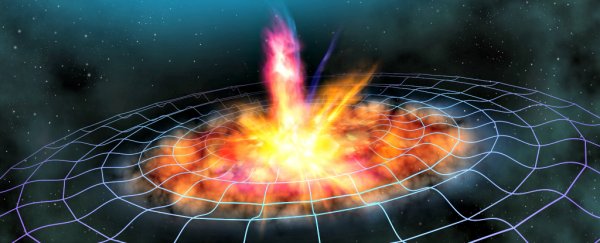The speed of light in a vacuum, or c, is pretty much the most fundamental constant in physics – and according to the general theory of relativity, gravity travels at the same rate.
But a new study suggests that the speed of light might not have always been this speed. In fact, in the early Universe, light might have outpaced gravity, and this new hypothesis could solve one of the biggest problems in physics.
Best of all, unlike a lot of hypotheses put forward in theoretical physics, this one can actually be tested, so we should be able to find out in the coming years if it's true or not.
So what's wrong with the speed of light and gravity in the first place? This conundrum comes from the earliest days of the Universe, and something called the horizon problem.
The horizon problem basically deals with the fact that the Universe reached a uniform temperature long before light particles (or photons) would have had time to reach all corners of the Universe.
If the speed of light in a vacuum really is constant, and always has been, then how did the cosmos heat up so fast?
Usually this problem is dealt with by the idea of inflation – which suggests that the Universe went through a huge period of expansion early on.
The hypothesis is that the temperature must have evened out when the Universe was all small and condensed, back when light didn't have as far to travel, and then it rapidly grew.
That makes sense – except no one knows why inflation started or stopped, and there's no way of testing it.
An alternative hypothesis has now been put forward by physicist Niayesh Ashfordi from the Perimeter Institute in Canada, and João Magueijo from Imperial College London.
Their idea is this: in the earliest days of the Universe, light and gravity travelled at different speeds.
This could mean that light used to travel faster than it does now, or gravity might have travelled slower.
Either way, "if photons moved faster than gravity just after the Big Bang, that would have let them get far enough for the Universe to reach an equilibrium temperature much more quickly," the researchers told Michael Brooks over at New Scientist.
For now, this is just an hypothesis. But the really exciting part is that it can actually be tested.
If the hypothesis is true, there will be a particular signature left in the cosmic microwave background radiation – the leftover radiation from the Big Bang that we can still detect and study today.
The team was able to calculate that a value called the spectral index – which describes the initial density ripples in the Universe – would have a fixed value if their hypothesis is right: 0.96479.
Interestingly, the latest spectral index figure reported last year by the Planck satellite, which maps the cosmic microwave background, was around 0.968 – not that far off the number you'd expect to see if light and gravity once travelled at different speeds.
More data from the Planck satellite will be able to show once and for all whether those numbers match up.
If they don't, the team is fine with that.
"That would be great – I won't have to think about these theories again," Magueijo told New Scientist. "This whole class of theories in which the speed of light varies with respect to the speed of gravity will be ruled out."
But if the cosmic microwave background's spectral index really does match the predicted value, then it would have huge implications for our understanding of physics.
Right now, there's a big gap between the way the Universe seems to operate on the quantum scale (quantum mechanics), and how it operates on the visible scale ( general relativity), and physicists are desperately looking for a 'theory of quantum gravity' to try to unite the two.
"If there is a good fit between Magueijo's theory and observations, it could bridge this gap, adding to our understanding of the Universe's first moments," says Brooks.
"We have a model of the Universe that embraces the idea there must be new physics at some point," added Magueijo. "It's complicated, obviously, but I think ultimately there will be a way of informing quantum gravity from this kind of cosmology."
The research will be published in Physical Review on November 28, but you can read it in full now at arXiv.org.
